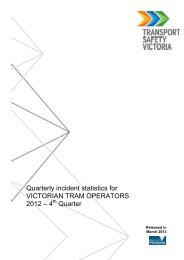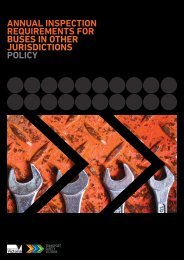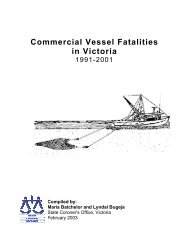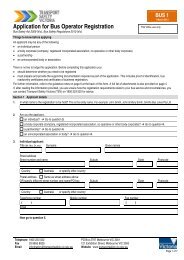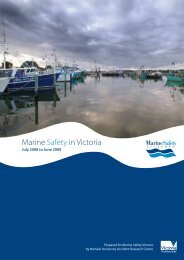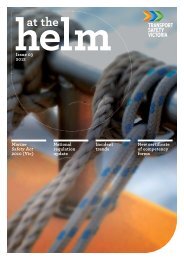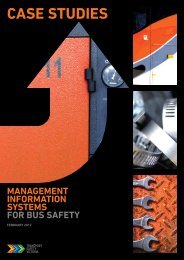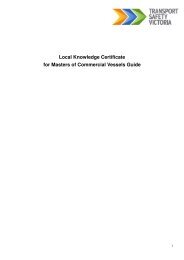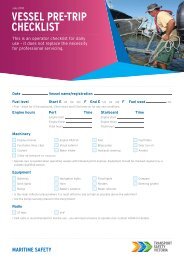Marine Safety in Victoria Report 2007-2008 (PDF, 1.3 MB, 72 pp.)
Marine Safety in Victoria Report 2007-2008 (PDF, 1.3 MB, 72 pp.)
Marine Safety in Victoria Report 2007-2008 (PDF, 1.3 MB, 72 pp.)
You also want an ePaper? Increase the reach of your titles
YUMPU automatically turns print PDFs into web optimized ePapers that Google loves.
ehavioural problems. The third patient was surf<strong>in</strong>g close to shore when the w<strong>in</strong>d picked up strength<br />
and he was thrown over a dyke and aga<strong>in</strong>st a parked car. His ma<strong>in</strong> <strong>in</strong>juries were a dislocated shoulder,<br />
a fractured femur and face lacerations. The fourth patient was thrown onto the beach but suffered only<br />
m<strong>in</strong>or chest <strong>in</strong>juries. The fifth was killed when walk<strong>in</strong>g with his kite toward the waterfront <strong>in</strong> stormy<br />
weather. He was caught by a sudden gust of w<strong>in</strong>d and thrown face first aga<strong>in</strong>st a wooden pile. The risk<br />
factors for serious <strong>in</strong>jury <strong>in</strong> these cases were similar to those reported previously: surf<strong>in</strong>g too close to shore;<br />
loss of kite control and a specific w<strong>in</strong>d condition called onshore flow.<br />
Skills and safety tra<strong>in</strong><strong>in</strong>g to <strong>in</strong>crease knowledge and practice of safety protocols, avoidance of<br />
overpower<strong>in</strong>g w<strong>in</strong>ds and better selection of site and conditions, and the fitt<strong>in</strong>g and use of quick release<br />
safety systems (<strong>in</strong>clud<strong>in</strong>g a release on the foot strap) and helmet wear<strong>in</strong>g all have the potential to reduce<br />
<strong>in</strong>juries <strong>in</strong> these w<strong>in</strong>d-powered sports. The <strong>in</strong>troduction of a mandatory certificate of competence has<br />
been proposed for kitesurf<strong>in</strong>g.<br />
Prevent<strong>in</strong>g <strong>in</strong>jury <strong>in</strong> fish<strong>in</strong>g<br />
The activity codes on the hospital admissions dataset (VAED) <strong>in</strong>cludes a code for ‘fish<strong>in</strong>g’ but there<br />
are only three sub-codes: rock fish<strong>in</strong>g, other specified fish<strong>in</strong>g and fish<strong>in</strong>g, unspecified. Consequently,<br />
hospitalisations related to fish<strong>in</strong>g from a boat cannot be disaggregated. For ED presentations recorded<br />
on the VEMD, case identification is based on a word search of case narratives but few of the narratives that<br />
conta<strong>in</strong> the search term ‘fish<strong>in</strong>g’ provide more detail about the sett<strong>in</strong>g (boat, pier, jetty, river bank etc.).<br />
These weaknesses result <strong>in</strong> the under-report<strong>in</strong>g of <strong>in</strong>juries related to fish<strong>in</strong>g from a vessel.<br />
In 2006/7, there were 2 deaths and 28 reported hospital-treated fish<strong>in</strong>g <strong>in</strong>juries, the same number of<br />
hospital-treated <strong>in</strong>juries as <strong>in</strong> 2005/6. As previously reported both deaths were due to drown<strong>in</strong>g and<br />
neither of the decedents was wear<strong>in</strong>g a PFD. There were few details on the hospital-treated <strong>in</strong>jury cases.<br />
Hospitalisations were mostly fracture cases that occurred <strong>in</strong> ‘on-board <strong>in</strong>cidents’ and accidents to craft.<br />
Less serious <strong>in</strong>juries were ma<strong>in</strong>ly cutt<strong>in</strong>g and pierc<strong>in</strong>g by fishhooks, wires and spikes.<br />
Comments on MIR system data quality<br />
S<strong>in</strong>ce 2004/5 the frequency of reported commercial and recreational vessel <strong>in</strong>cidents has steadily<br />
<strong>in</strong>creased probably reflect<strong>in</strong>g improved report<strong>in</strong>g rather than a real <strong>in</strong>crease <strong>in</strong> <strong>in</strong>cidents. However, the<br />
amount of miss<strong>in</strong>g data on some variables rema<strong>in</strong>s problematic. Variables that conta<strong>in</strong> substantial miss<strong>in</strong>g<br />
data <strong>in</strong>clude: <strong>in</strong>cident sub-type for ‘response-only’ commercial <strong>in</strong>cidents; visibility, w<strong>in</strong>d speed, weather<br />
and water conditions for commercial vessel <strong>in</strong>cidents; vessel activity for commercial vessel <strong>in</strong>cidents; and<br />
the role of the <strong>in</strong>jured person, activity of persons onboard and the operator’s licence status for recreational<br />
vessel <strong>in</strong>cidents.<br />
In <strong>2007</strong>/8 contributory factors were recorded for 96% of commercial vessel response only <strong>in</strong>cidents and<br />
60% of commercial vessel serious <strong>in</strong>cidents compared with report<strong>in</strong>g rates of 56% and 51% respectively <strong>in</strong><br />
2006/7. This data item was well recorded for recreational vessel ‘response only’ (89%) and ‘serious’ (94%)<br />
<strong>in</strong>cidents. These data provided more useful <strong>in</strong>formation on the relative contribution of material, human<br />
and environmental factors to <strong>in</strong>cidents than previous years.<br />
64



